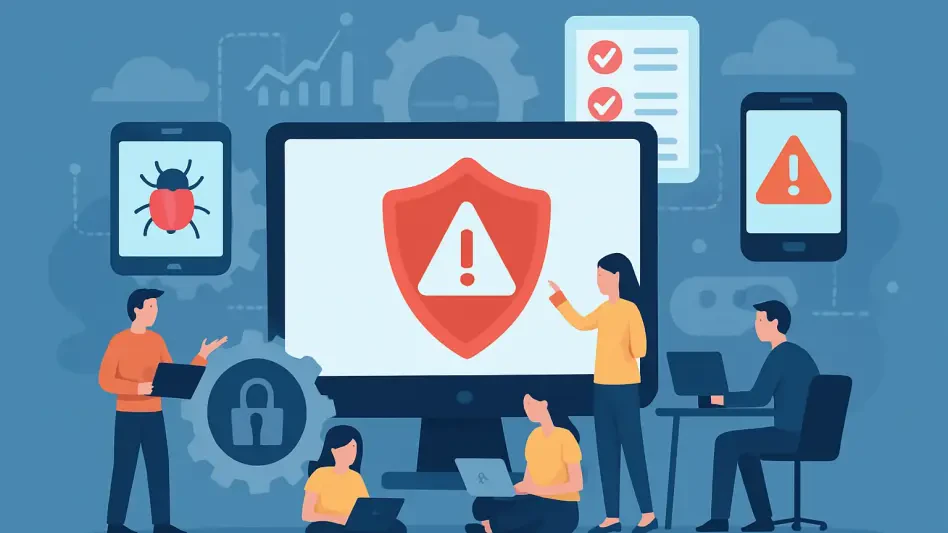Throughout 2024, there has been an alarming surge in cyberattacks exploiting vulnerabilities in edge devices, according to research by Darktrace. These devices, including Ivanti Connect Secure, Ivanti Policy Secure appliances, and firewall products from Fortinet and Palo Alto Networks, have presented significant security challenges. Repeated attacks have exploited zero-day and n-day vulnerabilities, resulting in severe breaches. As cyber attackers increasingly target these critical network points, the need for robust security measures and prompt patch management has never been more paramount.
The Rise of Exploited Vulnerabilities
Ivanti Product Vulnerabilities
A particularly disturbing trend has been targeting Ivanti products, notably CVE-2023-46805 and CVE-2024-21887. Attackers have seized these vulnerabilities to infiltrate networks through Ivanti Connect Secure and Ivanti Policy Secure appliances. The zero-day nature of these vulnerabilities means they are unknown to the software vendor when first exploited, giving attackers a potent advantage. The prolonged period during which these vulnerabilities remain exploitable, before users can implement patches, exacerbates the risks they pose. For organizations with limited resources, timely implementation of patches becomes increasingly challenging, making these devices prime targets.
Once attackers gain access through Ivanti vulnerabilities, they can execute sophisticated “living-off-the-land” techniques, which involve leveraging existing software and tools within an organization’s network. By stealing credentials or obtaining persistent network access, attackers can move laterally across the network, often remaining undetected. This ability to blend in with regular network traffic makes it exceedingly difficult to identify and mitigate attacks swiftly. Consequently, organizations must be vigilant and proactive in managing vulnerabilities and ensuring that patch management processes are robust and timely.
Palo Alto Networks and Fortinet Firewall Exploits
Similarly, Palo Alto Networks and Fortinet’s firewall products have been prime targets for cyber attackers. Key vulnerabilities, including CVE-2024-3400, CVE-2024-0012, and CVE-2024-9474 in Palo Alto Networks firewalls, as well as CVE-2024-47575 in Fortinet’s FortiManager, have been heavily exploited throughout 2024. These vulnerabilities allow attackers to circumvent the very security measures meant to protect network infrastructure. Threat actors, including nation-states and financially motivated groups, have increasingly focused resources on reverse-engineering these devices to understand and exploit their flaws.
The exploitation of security products themselves underscores the gravity of these threats. Once compromised, these devices, intended as protective barriers, become gateways for extensive attack campaigns. In many cases, the initial breach of firewalls provides continued access for deployment of malware or other payloads. The reliance on edge devices for critical network security further magnifies the impact of these vulnerabilities. Their criticality makes thorough and regular security audits, alongside prompt action on patch releases, absolutely essential for mitigating risks.
The Broader Cybersecurity Landscape
Increased Sophistication in Attack Strategies
In 2024, Darktrace’s research has highlighted the increased sophistication of attack strategies targeting edge device vulnerabilities. Attackers are not only leveraging known weaknesses but are actively reverse-engineering products to discover potential exploit vectors. This evolution in tactics reflects a broader trend in the cybersecurity landscape, where the complexity and frequency of attacks continue to rise. The implication is clear: cybersecurity defenses must evolve correspondingly, anticipating threats before they materialize.
The observed malicious activity involving internet-facing devices accounted for 40% of all detected threats in the first half of the year. This statistic illustrates the significant focus cybercriminals have directed towards these devices. Information-stealing malware became particularly prominent towards the latter half of the year, indicating a strategic shift towards exfiltrating valuable data. The convergence of advanced persistent threats and the increased use of sophisticated malware strains necessitates a dynamic, agile approach to cybersecurity.
The Imperative of Enhanced Security Measures
Throughout 2024, a concerning increase in cyberattacks targeting vulnerabilities in edge devices has been reported by Darktrace’s research. These edge devices, which include Ivanti Connect Secure, Ivanti Policy Secure appliances, and various firewall products from Fortinet and Palo Alto Networks, have posed significant security issues. Persistent attacks have taken advantage of zero-day and n-day vulnerabilities, leading to serious security breaches. With cyber attackers focusing more on these vital network points, the importance of strong security measures and timely patch management has escalated. The cyber landscape has become increasingly hazardous, demanding heightened vigilance and enhanced security protocols to safeguard sensitive data. Therefore, organizations must prioritize identifying and mitigating vulnerabilities in their edge devices to prevent such unprecedented breaches and ensure network integrity remains intact. Robust defenses are essential to protect against the sophisticated strategies employed by cyber adversaries who continuously evolve their tactics.







